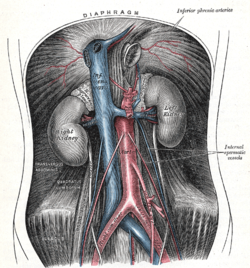The organ of Zuckerkandl is a chromaffin body derived from the neural crest located at the bifurcation of the aorta or at the origin of the inferior mesenteric artery. It can be the source of a paraganglioma.[1]
| Organ of Zuckerkandl | |
|---|---|
 The abdominal aorta and its branches. (Organ of Zuckerkandl is not shown, but it usually appears alongside the abdominal aorta.) | |
| Identifiers | |
| MeSH | D010220 |
| TA98 | A12.2.04.003 |
| TA2 | 3889 |
| FMA | 15647 |
| Anatomical terminology | |
The term para-aortic body is also sometimes used to describe it, as it usually arises near the abdominal aorta, but this term can be the source of confusion, because the term "corpora paraaortica" is also used to describe the aortic body, which arises near the thoracic aorta. This diffused group of neuroendocrine sympathetic fibres was first described by Emil Zuckerkandl, a professor of anatomy at the University of Vienna, in 1901.[2]
Some sources equate the "aortic bodies" and "paraaortic bodies",[3] while other sources explicitly distinguish between the two.[4][5] When a distinction is made, the "aortic bodies" are chemoreceptors which regulate circulation, while the "paraaortic bodies" are the chromaffin cells which manufacture catecholamines.
Organs of Zuckerkandl (O of Z) harbor the potential for deadly paragangliomas. Paragangliomas are one of the surgical causes of hypertension. Major treatises of medicine offer very little information on this topic.[6]
Structure
editThis section needs expansion. You can help by adding to it. (September 2014) |
Function
editIts physiological role is thought to be of the greatest importance during the early gestational period as a homeostatic regulator of blood pressure, secreting catecholamines into the fetal circulation.
The organ itself regresses in the late third trimester and following birth to form the aorticosympathetic group of the adult paraganglia.[7]
Clinical significance
editPathology
editIt can be the source of paraganglioma.[8]
The organ of Zuckerkandl is of pathological significance in the adult as a common extra-adrenal site of pheochromocytoma though the most common extra-adrenal site is in the superior para-aortic region between the diaphragm and lower renal poles.[9]
Extra-adrenal tumors account for around 25% of all cases of pheochromocytoma.[10] Resection has been described.[11]
In addition to its endocrine effects, it can also cause obstructive pathology.[12]
References
edit- ^ Dossett, Lesly; Rudzinski, Erin; Blevins, Lewis; Chambers, Eugene (2007). "Malignant Pheochromocytoma of the Organ of Zuckerkandl Requiring Aortic and Vena Caval Reconstruction". Endocrine Practice. 13 (5): 493–7. doi:10.4158/ep.13.5.493. PMID 17872352.
- ^ synd/3111 at Who Named It?
- ^ "organs of Zuckerkandl" at Dorland's Medical Dictionary
- ^ Aortic+Bodies at the U.S. National Library of Medicine Medical Subject Headings (MeSH)
- ^ Para-Aortic+Bodies at the U.S. National Library of Medicine Medical Subject Headings (MeSH)
- ^ Subramanian, Anuradha; Maker, Vijay K. (2006-08-01). "Organs of Zuckerkandl: their surgical significance and a review of a century of literature". The American Journal of Surgery. 192 (2): 224–234. doi:10.1016/j.amjsurg.2006.02.018. ISSN 0002-9610. PMID 16860635.
- ^ Schober, Andreas; Parlato, Rosanna; Huber, Katrin; Kinscherf, Ralf; Hartleben, Björn; Huber, Tobias B.; Schütz, Günther; Unsicker, Klaus (2013). "Cell Loss and Autophagy in the Extra-Adrenal Chromaffin Organ of Zuckerkandl are Regulated by Glucocorticoid Signalling". Journal of Neuroendocrinology. 25 (1): 34–47. doi:10.1111/j.1365-2826.2012.02367.x. ISSN 0953-8194. PMC 3564403. PMID 23078542.
- ^ Saurborn, Daniel P.; Kruskal, Jonathan B.; Stillman, Isaac E.; Parangi, Sareh (2003). "Best Cases from the AFIP". RadioGraphics. 23 (5): 1279–86. doi:10.1148/rg.235035022. PMID 12975514.
- ^ Whalen, R. K.; Althausen, A. F.; Daniels, G. H. (1992). "Extra-adrenal pheochromocytoma". The Journal of Urology. 147 (1): 1–10. doi:10.1016/s0022-5347(17)37119-7. PMID 1729490.
- ^ Thompson, Robert W. (2002). "Detection and Management of Small Aortic Aneurysms". New England Journal of Medicine. 346 (19): 1484–6. doi:10.1056/NEJM200205093461910. PMID 12000820.
- ^ Kravarusic, Dragan; Pinto-Rojas, Alfredo; Al-Assiri, Ali; Sigalet, David (2007). "Laparoscopic resection of extra-adrenal pheochromocytoma—Case report and review of the literature in pediatric patients". Journal of Pediatric Surgery. 42 (10): 1780–4. doi:10.1016/j.jpedsurg.2007.06.025. PMID 17923216.
- ^ Blecha, Matthew; Galanopolous, Christos; Dharkar, Dilip; Salti, George (2005). "Massive Organ of Zuckerkandl Inducing Small Bowel Obstruction". Journal of the American College of Surgeons. 201 (3): 480–1. doi:10.1016/j.jamcollsurg.2005.02.031. PMID 16125084.
External links
edit- 00520 at CHORUS